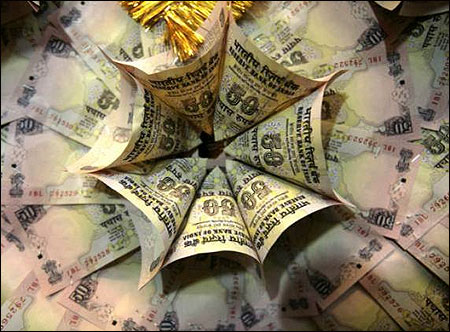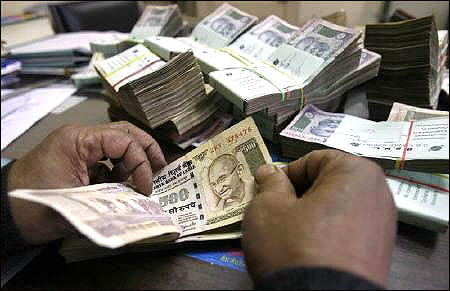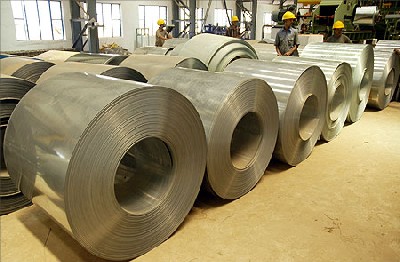 | « Back to article | Print this article |
The mystery of the Rs 1,00,000-cr bill
The private sector has been bitterly complaining about the logjam in permissions and approvals, resulting in delayed projects. While private capital has no doubt suffered as have investors, the biggest loser from Government's delays is perhaps the Government itself. And thus, the taxpayer.
A report prepared by the Government's Ministry of Programme Planning & Statistics shows that cost over-runs, just for projects with investment outlays of over Rs 1,000 crore (Rs 10 billion), are a staggering Rs 1,00,000 crore (Rs 1,000 billion) or $23 billion. IndiaSpend takes a closer look at the projects and the departments that were responsible.
Its quite likely that a Rs 1,00,000 crore (Rs 1,000 billion) bill as computed by the Ministry of Programe Planning & Statistics in its report released recently (dated June 2011) would be disputed by some of the implementing Government departments. Also, not all of it will have a budgetary burden as the operating organisations are public sector companies.
But then, budgetary outlays merit study too. For example, the Ministry of Finance's mid-term review (released in December 2011) says the approved plan outlay for civil aviation for 2011-12 is Rs 9,072 crore (Rs 90.72 billion), including a budgetary support of Rs 1,700 crore (Rs 17 billion). But of this, only Rs 2,774 crore (Rs 27.74 billion) is for infrastructure development of airports while Rs 5,749 crore (Rs 57.49 billion) is for Air India's aircraft acquisition.
Click NEXT to read more...
The mystery of the Rs 1,00,000-cr bill
Lack of clarity
It's perhaps indicative of the manner in which projects are executed that of the 158 projects under study, 13 projects do not even have firm commissioning dates, while 25 projects were sanctioned without any commissioning date, though they were fixed later.
The overall figure is worrying, partly for the size which in itself will not be the final one but for the way in which billions of dollars get hidden away amidst a multitude of projects few people from the 'outside world' would examine closely. So, the total computed investment figure is Rs 4,80,284 crore ($106 billion) while the total figure after delays (as they stand currently) is at Rs 5,80,781 crore ($129 billion). The gap is Rs 1,00,000 crore (Rs 1,000 billion).
Now this figure is only anticipated and stands a good chance of ballooning further, given the current trend. Moreover, as we mentioned earlier, this figure was frozen in June 2011. There is no way things could have got better.
So, who are the big offenders? Surprisingly, at least from a cost point of view, they are not who you might think. For instance, atomic energy in public memory is facing the maximum opposition to its projects and sites (Kudankulam, Jaitapur). But it is sectors like water resources, urban development, railways, steel and coal as the table below shows.
Click NEXT to read more...
The mystery of the Rs 1,00,000-cr bill
The worst offenders
In areas like power, roads & transport, shipping & ports and mines, where one arguably sees more debate, the delays are marginal. The next big deck of offenders are telecom and of course atomic energy.
Actually, in our understanding, it's the time over-run figures which correspond more to the headlines you might have seen or conversations you recall. Overall, railways are the worst offender on time scales with project delays ranging from 3 to 201 months. That's going up to 16 years!
Petroleum comes next with delays from 16 to 120 months. Water Resources is around 60 months while coal, mines and steel are between 25 and 50 months.
The biggest offenders in absolute terms are Delhi, Chhattisgarh, J&K and Maharashtra where the over-runs are more than Rs 10,000 crore (Rs 1,00 billion) with Maharashtra leading the pack.
Remarkably, the figures for Gujarat show a reduction, almost by half from around Rs 24,274 crore (Rs 242.74 billion) to Rs 12,993 crore (Rs 129.93 billion). Tamil Nadu and Karnataka are similarly positioned with approximately Rs 5,000 crore (Rs 50 biilion) of over-runs.
Click NEXT to read more...
The mystery of the Rs 1,00,000-cr bill
Now let's look at some specific sectors:
Steel
This sector is the biggest culprit, mostly between steel majors SAIL and Rashtriya Ispat Nigam Limited (RINL). For instance, RINL's cost of raising capacity from 3 to 6.3 million tonnes has gone from Rs 8,692 crore (Rs 86.92 billion) to Rs 12,291 crore (Rs 122.91 billion).
The cost of an expansion at Rourkela Steel (undefined) has gone from Rs 6,133 crore (Rs 61.33 billion) to Rs 11,182 crore (Rs 111.82 billion).
The big one is Bhilai Steel Plant where expansion costs have ballooned from Rs 5,185 crore (Rs 51.85 billion) to Rs 17,265 crore (Rs 172.65 billion). Bhilai has a current capacity of 3.1 million tonnes and trade disputes (reports) over the import of Russian machinery could be one reason.
Click NEXT to read more...
The mystery of the Rs 1,00,000-cr bill
Atomic power
Kudankulam which began with a project cost of Rs 13,171 crore [Rs 131.71 billion] (a figure that's not easy to find in most government records) is now staring at a Rs-15,824 (Rs-158.24 billion) bill.
And as anyone reading the news on the local protests would know, is only going to get bigger. The other surprise is the Prototype Fast Breeder Reactor in Bhavni in Tamil Nadu where the cost has shot up from Rs 3,492 crore (Rs 34.92 billion) to Rs 5,677 crore (Rs 56.77 billion).
Coal
The cost of a coal mine expansion project in (Gevra) in Chhatisgarh has gone from Rs 1,667 crore (Rs 16.67 billion) to Rs 2,676 crore (Rs 26.76 billion).
Similarly, Dipka also in Chattisgarh has gone from Rs 1,268 crore (Rs 12.68 billion) to Rs 1,943 crore (Rs 19.43 billion). Or Kusmunda, also in Chattisgarh, which has gone from Rs 738 crore (Rs 7.38 billion) to Rs 1,188 crore (Rs 11.88 billion). This is possibly due to local law and order problems as well.
Click NEXT to read more...
The mystery of the Rs 1,00,000-cr bill
Oil & Gas
The cost of building a new process complex by ONGC in Mumbai High North went up from Rs 2,853 crore (Rs 28.53 billion) to Rs 6,326 crore (Rs 63.26 billion) and the project is approximately two years behind schedule.
The cost of integrated development in oilfields G1 and GS-15 rose from Rs 430 crore (Rs 4.3 billion) to Rs 2,218 crore (Rs 22.18 billion).
This project is approximately 5 years behind schedule. Another Mumbai High South redevelopment is now costing Rs 8,813 crore (Rs 88.13 billion) from Rs 5,713 crore (Rs 57.13 billion), with a 3-year delay in implementation.
Click NEXT to read more...
The mystery of the Rs 1,00,000-cr bill
Power
Hydro Electric Power doesn't seem to sway away from the common trend that we have seen in the other sectors too.
As you can see below, the cost of NHPC's Kishanganga Hydro Electric Plant has gone up from Rs 2,239 crore (Rs 22.39 billion) to Rs 3,642 crore (Rs 36.42 billion).
Tehri Hydro Development Corporation Ltd (THDCL) has also witnessed a similar trend in both its facilities in Uttarkhand too.
Reprinted with permission from www.indiaspend.com






